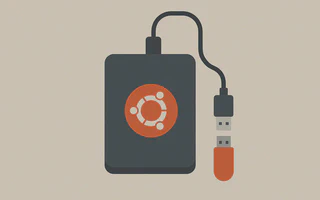Ubuntu Live USB

Compré un case Vantec NexStar CX para usar un HDD de 2.5" como disco externo.
Como el HDD tiene bastante espacio y siempre necesito un Live CD de Linux para arreglar algo, decidí instalar Ubuntu al principio de ese HDD.
Este proceso es bastante sencillo en Ubuntu, que trae un “Disk Creator”, pero en Arch Linux tendría que descargar algo similar o hacerlo manualmente. Aquí muestro cómo hacerlo a mano.
Descarga la imagen .iso en http://www.ubuntu.com/download
Instala
syslinuxyms-sysjulio@julio-acer ~> sudo pacman -S syslinux mtools julio@julio-acer ~> yaourt ms-sysConecta el HDD externo a un puerto USB y localiza el dispositivo con
fdisk -l(/dev/sdcaquí)julio@julio-acer ~ $ sudo fdisk -l Disk /dev/sdc: 500.1 GB, 500107862016 bytes 171 heads, 40 sectors/track, 142803 cylinders, total 976773168 sectors Units = sectors of 1 * 512 = 512 bytes Sector size (logical/physical): 512 bytes / 512 bytes I/O size (minimum/optimal): 512 bytes / 512 bytes Disk identifier: 0x000de160 Device Boot Start End Blocks Id System /dev/sdc1 2048 2099199 1048576 b W95 FAT32Asegúrate de que el disco no tenga nada importante. Fórmatalo, crea una partición de al menos 1 GB y márcala como arrancable (bootable).
julio@julio-acer ~> sudo fdisk /dev/sdc Command (m for help): d Selected partition 1 Command (m for help): n Command action e extended p primary partition (1-4) p Partition number (1-4, default 1): 1 First sector (2048-976773167, default 2048): 2048 Last sector, +sectors or +size{K,M,G} (2048-976773167, default 976773167): +1G Command (m for help): t Selected partition 1 Hex code (type L to list codes): c Changed system type of partition 1 to c (W95 FAT32 (LBA)) Command (m for help): a Partition number (1-4): 1 Command (m for help): w The partition table has been altered! Calling ioctl() to re-read partition table. WARNING: If you have created or modified any DOS 6.x partitions, please see the fdisk manual page for additional information. Syncing disks.Usa mkfs para crear un sistema de archivos FAT32:
julio@julio-acer ~ $ sudo mkfs.vfat -F 32 /dev/sdc1Reescribe el MBR
julio@julio-acer ~ $ sudo dd if=/dev/zero of=/dev/sdc bs=446 count=1 1+0 records in 1+0 records out 446 bytes (446 B) copied, 0.00234799 s, 190 kB/sjulio@julio-acer ~ $ sudo ms-sys -s /dev/sdc Public domain syslinux master boot record successfully written to /dev/sdcMonta el HDD externo
julio@julio-acer ~ $ sudo mount /dev/sdc1 /media/pendrive/Instala GRUB en la primera partición
julio@julio-acer ~ $ sudo grub-install - -no-floppy - -root-directory=/media/pendrive/ /dev/sdcMonta la imagen .iso
julio@julio-acer ~ $ sudo mount -o loop ubuntu-11.04-desktop-i386.iso /media/iso/ mount: warning: /media/iso/ seems to be mounted read-only.Copia el kernel y el initrd del .iso a la carpeta /boot
julio@julio-acer ~> sudo cp /media/iso/casper/{vmlinuz,initrd.lz} /media/pendrive/boot/Reserva 512 MB para el archivo casper-rw, que almacenará todos los archivos y modificaciones realizadas en el sistema.
julio@julio-acer ~> sudo dd if=/dev/zero of=/media/pendrive/casper-rw bs=1M count=512 512+0 records in 512+0 records out 536870912 bytes (537 MB) copied, 1.92945 s, 278 MB/sjulio@julio-acer ~> sudo mkfs.ext3 -F /media/pendrive/casper-rw mke2fs 1.41.14 (22-Dec-2010) Filesystem label= OS type: Linux Block size=4096 (log=2) Fragment size=4096 (log=2) Stride=0 blocks, Stripe width=0 blocks 32768 inodes, 131072 blocks 6553 blocks (5.00%) reserved for the super user First data block=0 Maximum filesystem blocks=134217728 4 block groups 32768 blocks per group, 32768 fragments per group 8192 inodes per group Superblock backups stored on blocks: 32768, 98304 Writing inode tables: done Creating journal (4096 blocks): done Writing superblocks and filesystem accounting information: done This filesystem will be automatically checked every 38 mounts or 180 days, whichever comes first. Use tune2fs -c or -i to override.Crea una segunda partición para almacenar el .iso
julio@julio-acer ~> sudo fdisk /dev/sdc Command (m for help): n Command action e extended p primary partition (1-4) p Partition number (1-4, default 2): 2 First sector (2099200-976773167, default 2099200): Using default value 2099200 Last sector, +sectors or +size{K,M,G} (2099200-976773167, default 976773167): +730M Command (m for help): w The partition table has been altered! Calling ioctl() to re-read partition table. Syncing disks.Copia los archivos del .iso a la segunda partición
julio@julio-acer ~> sudo dd if=ubuntu-11.04-desktop-i386.iso of=/dev/sdc2 1403484+0 records in 1403484+0 records out 718583808 bytes (719 MB) copied, 116.572 s, 6.2 MB/sEdita el menú de Grub
julio@julio-acer .../pendrive/boot/grub> cat menu.lst default 0 timeout 10 title Ubuntu (Live) root (hd0,0) kernel /boot/vmlinuz boot=casper file=/preseed/ubuntu.seed persistent initrd /boot/initrd.lzDesmonta el disco, configura la BIOS para arrancar desde USB y prueba tu live USB.